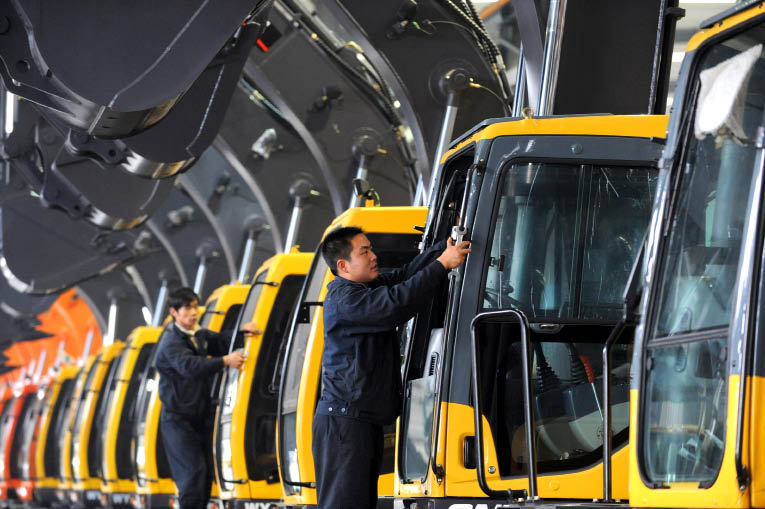|
The Future of "Made in China"
By BAI MING
SINCE its emergence in Guangdong Province in 1978, the processing trade in China has developed rapidly. The processing trade refers to the process by which raw and auxiliary materials, parts and components, accessories and packaging materials are imported from abroad and used to produce a finished product which are then re-exported. In 1996, the processing trade became the principal form of international trade on the Chinese mainland. China henceforth became the world's biggest workshop. "Made-in-China" products have flourished in almost every corner of the planet, loved for their affordable prices.
 |
| Workers conduct the final test of a vehicle at the plant of Chongqing Kinbull Construction Machinery Co., Ltd. in Chongqing. CFP |
The thriving of China's processing trade has been seen as a result of the combination of the globalization trend in the world economy and the inherent nature of China's economic realities. This trade helps China make optimal use of its abundant labor supply and exploit international resources including advanced technologies, capital and marketing channels. Boosted by the mass transfer of foreign industries to Chinese shores, the processing trade plays an important role in such aspects of development as expanding exports, promoting employment, increasing revenues and stimulating growth of related industries.
China's entry to the World Trade Organization (WTO) in 2001 has lent more momentum to its processing trade. According to statistics released by Chinese Customs, the import and export volume of China's processing trade rose to US $1.16 trillion in 2010, marking an annual increase of 19.1 percent from US $241.43 billion in 2001.
A Remarkable Achievement
China's processing trade rose on the back of the nation's low labor and land costs. However as these advantages gradually disappear and the Chinese people's concern for the environment increases, the focus of China's processing trade development has shifted from sheer volume to the strength and health of the sector.
As an important indicator of the overall level of processing trade, the value-added ratio of the processing trade, the ratio of export value to import value over a specific period, reflects the size of added value in processing. This indicator is useful in understanding the position of China's processing trade in the global industrial chain. Since its accession to the WTO, China has successfully sustained the expansion of its processing trade. This growth has relied more on improvements in efficiency than on the expansion of trade volume. Thus, although the proportion of processing exports to overall exports has been declining, its value-added ratio has continued to rise. Over the decade from 2001, the year in which China joined the WTO, to 2010, the proportion of processing exports to China's overall exports dropped from 55.4 percent to 46.9 percent, while the value-added ratio climbed from 56.9 percent to 77.4 percent.
The rise of the value-added ratio of the processing trade not only signifies the increasing role that the sector plays in driving the domestic economy, but also reflects the progress China has made in transforming and upgrading its processing trade. This project has proved to be an exceptionally difficult to carry out, and there are still many challenges to be faced. For one, weak in research and development, Chinese enterprises engaged in the processing trade remain at the lower end of the international industrial chain with regards to added value, and this makes it difficult for them to break away from the labor-intensive and low-added-value model. Take for example, a Barbie doll. It is sold for US $9.99 in the U.S market, but China's manufacturer sells it to the U.S. importer for a mere US $1, earning only 35 cents after costs are deducted. From a macroeconomic perspective, every RMB 1 worth of export in general trade contributes RMB 0.7 to China's domestic economy, while the figure is only RMB 0.3 for the processing trade
Starting in the second half of 2008, demand from the international market shrank as a result of the global financial crisis, and China's processing trade faced unprecedented difficulties. In 2009, China's processing trade volume declined by 13.7 percent. However, in retrospect we know the crisis offered China a strong incentive to transform and upgrade its processing trade. As the world economic meltdown shattered the status-quo of the international industrial chain, many Chinese enterprises dealing in the processing trade took advantage of the chance to improve the structure of their exports and increase their added value and technical content, building up momentum to challenge the old race leaders on the international market.
Of course, it takes more than endeavors by individual enterprises to help China's processing trade survive and grow in a worldwide crisis. Government support plays a vital role in this regard. To help these enterprises ride out the downturn and expand domestic demand, the government took measures to facilitate the domestic sale of processing trade products, such as relaxing and simplifying Customs declaration procedures. Owing to such help from the government, many enterprises survived the financial crisis, enabling the processing trade sector to make a strong and swift rebound once the world economy became more stable. In 2010, China's processing trade volume increased by 27.3 percent over the previous year, with exports rising 26.2 percent and imports up 29.5 percent.
|
